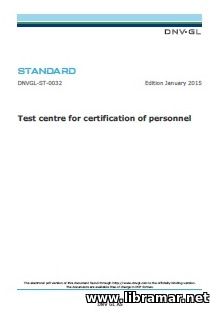 This standard was prepared by DNV GL class society with the objective to cover the competence certification within a specific target group, as per the recognizable, consistent and well-regarded standards, rules, technical specifications and testing methods, with the ultimate intention to limit the risk factor for certificate holders as well as all interested parties.
It covers all activities that take place within the certification system and applies to non-compulsory certification systems. Four sections of this publication cover the certification system, test requirements, examination and certification process, test centers and examinations. In addition, four appendices provide relevant supplementary information on regulations for examinations, complaints, objections and appeals, including ones concerning examination, and sample certificate of competence.
The above mentioned certification of competence can be implemented when requested by interested parties, as per ISO/IEC 17024:2003 standard. The generic certification system developed by this classification society consists of a framework which, in turn, consists of expertise, established procedures and technical instructions compliant with the standard of competence being is the subject of that certification.
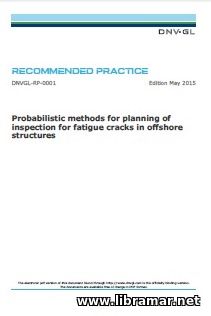 The declared aim of the authors of this recommended practice released by DNV GL class society was to provide the necessary guidelines for the proper understanding and correct use of various probabilistic methods for planning of the inspections of fatigue fractures in jacket structures, column stabilized units and floating production ships, including guidance for fatigue analysis of subject structures as required for the purpose of probabilistic analysis.
The methodology of analysis presented in this recommended practice is general and might be used for planning of the inspections of any other structures that are subjected to serious dynamic loads, for example jack-up structures. Sixteen sections of the document address applicable standards and reference technical documentation, planning of the inspection for fatigue cracks, overview of analyses described above, fatigue analyses based on S-N data and on fracture mechanics, assessment of probability of fatigue failure of the structure, target reliability, calibration of fracture mechanics models to the test data, and assessment of the input parameters, detection probability, validation of the results, inspection planning, reporting, examples of the inspection planning, references etc.
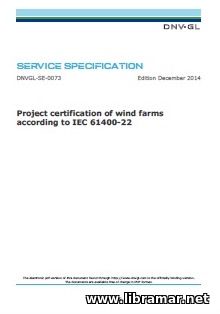 Here is another DNV GL service specification - this one has been fully dedicated to the wind farms and their assets, both offshore and onshore. The publication includes detailing and interpretation of the recognized IEC 61400-22 standard by this classification society and is primarily intended to serve as a contractual basis for project certification; in addition to that, the present document provides a basis to describe the extent and scope of the verification activities that are performed with the purpose of certification.
The paper has been divided by the authors into three big parts. The first part provides some general info on the wind farms and assets included in this SS as well as general requirements applicable to the project certification of such devices; the second part of the book provides reader with the overview of the certification service for various phases of the project; it also describes the deliverables of certification. The third part describes the certification services in detail - it refers to the complete certification of the wind farms with all assets, contains all necessary details of the services concerning the wind turbines and their supports, substations, as well as power cables, describes additional services and integration of certificates in a project certification.
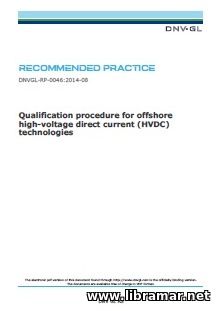 Here is the recommended practice prepared and released by DNV GL class society with the intention to provide a systematic method for qualification of the offshore high-voltage direct-current transmission technologies and provide necessary technical guidance on proper utilization of the generic qualification procedure for new technologies.
The scope of the present recommended practice shall apply to the offshore HVDC systems, their subsystems and components - all that may be defines as new high-voltage DC transmission concepts or technologies. The RP has been structured into three parts, namely introductory part, main body, and the appendices. The first part describes the objective, scope and structure of the document, provides some case examples, relationship of this RP with some other standards and codes etc.
The main body of the document introduces the reader to the offshore HVDC transmission technologies and technology qualification, qualification basis, technology and threat assessment, qualification and execution plan, performance assessment. Three appendices describe the qualification of an offshore point-to-point link, multi-terminal HVDC systems and standardization work and other initiatives...
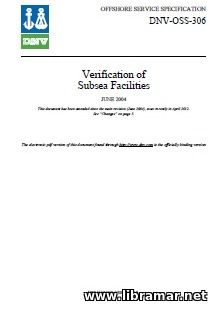 Here is another part of the inter-related offshore service specifications released by DNV classification society to provide the general description of the verification systematic - as implied by the title of this OSS, it provides readers with the instructions on proper application of the common framework and overview of the risk verification processes to the subsea facilities.
The authors of this document introduce a leveled description of the involvement of verification throughout the whole working life of the asset and facilitate a high/medium/low categorization of the risk that would definitely assist in risk evaluation; in addition, this specification is intended to assist when planning the verification through the preparation of the verification plan, and explain the associated DNV documentation. In fact, it may serve as the international standard that allows predictable and transparent scope of verification and defines the terminology for verification involvement.
The readers will find all required information on the verification plans, statements of compliance issued to the subsea facilities by DNV, overview of the service, proper selection of the verification level, example scopes of work tables and examples of verification documents etc. Falls under the DNV-OSS-300.
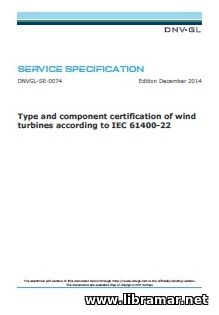 The authors of the present official DNV document declared two main objectives - the first is to serve as the description of the services provided by the DNV-GL class society relating to the type/component certification of wind turbines as per IEC 61400-22 standard, that would be available publicly, and to serve as a contractual document when making contracts between makers of the equipment and this classification society.
The present DNV-GL service specification is intended to describe this society's interpretation of the IEC 61400-22 standard and to cover some additional technical information that may be required for certification in accordance with the above mentioned standard. In this document the customer's obligations have been specified, covering the case where the wind turbine or its component or system is to be certified. In addition to that, this paper is to specify the obligations of this class society and all tasks performed by DNV-GL for certification.
It provides some sort of common platform to describe the extent and scope of the verification activities for type certification of turbines and their components, and to serve as a good reference source to define the work scope as required by the applicable certification scheme.
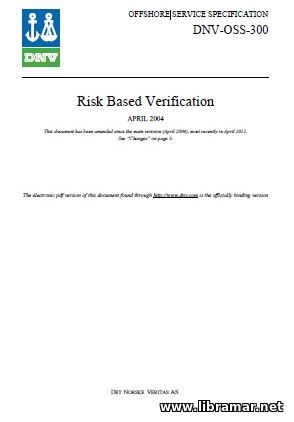 The present DNV OSS, i.e. Offshore Service Specification, is intended to provide readers with the comprehensive overview of the Verification services offered by this Classification Society. The main objectives of this specification are to fully describe the risk-based verification services provided by DNV, provide necessary guidance to ship owners and all other parties involved to let them make proper selection of the involvement level of the verifier, provide a sort of common platform for communication to describe the extent of required verification, and create an opportunity for establishing the efficient, predictable, transparent and, of course, cost effective scheme of verification.
This document would apply to verification conducted in the course of the assessment of the owner's control of the process and up to the completion of the asses and during the whole working life of the asset. The specification has been primarily intended to serve as a good reference for onshore/offshore installations and facilities. Apart from the information on principles of risk based verification, the specification provides list and explanation of the verification and certification documents, typical high risk elements, performance requirements etc.
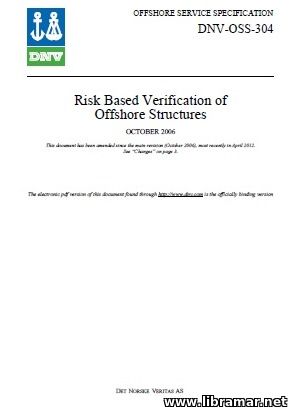 The present DNV offshore service specification is considered a second-tier document within a suite of service specifications that have been developed and issued by this Class Society and covering the certification and verification services offered by DNV to the oil and gas industry. The scope of the present official document was to provide detailed description of the approached used by DNV class society to verification of the various structures involved in the oil an gas industry.
The paper also describes the major elements of such verification and shall also exemplify the type and extent of the involvement of verification. The document starts with the introduction and basic information on risk based verification and associated plan, followed by the service overview section, explaining the service process, initiation, realization and operation of the project, and the list of verification documents.
Apart from that, the document contains guidance on the selection of the verification levels for design and fabrication, provides example scopes of verification for certification, examples of verification documents, use of QMS, document forms and some other useful information. Falls under the DNV-OSS-300.
« 1 2 ... 18 19 20 21 22 ... 29 30 » |







